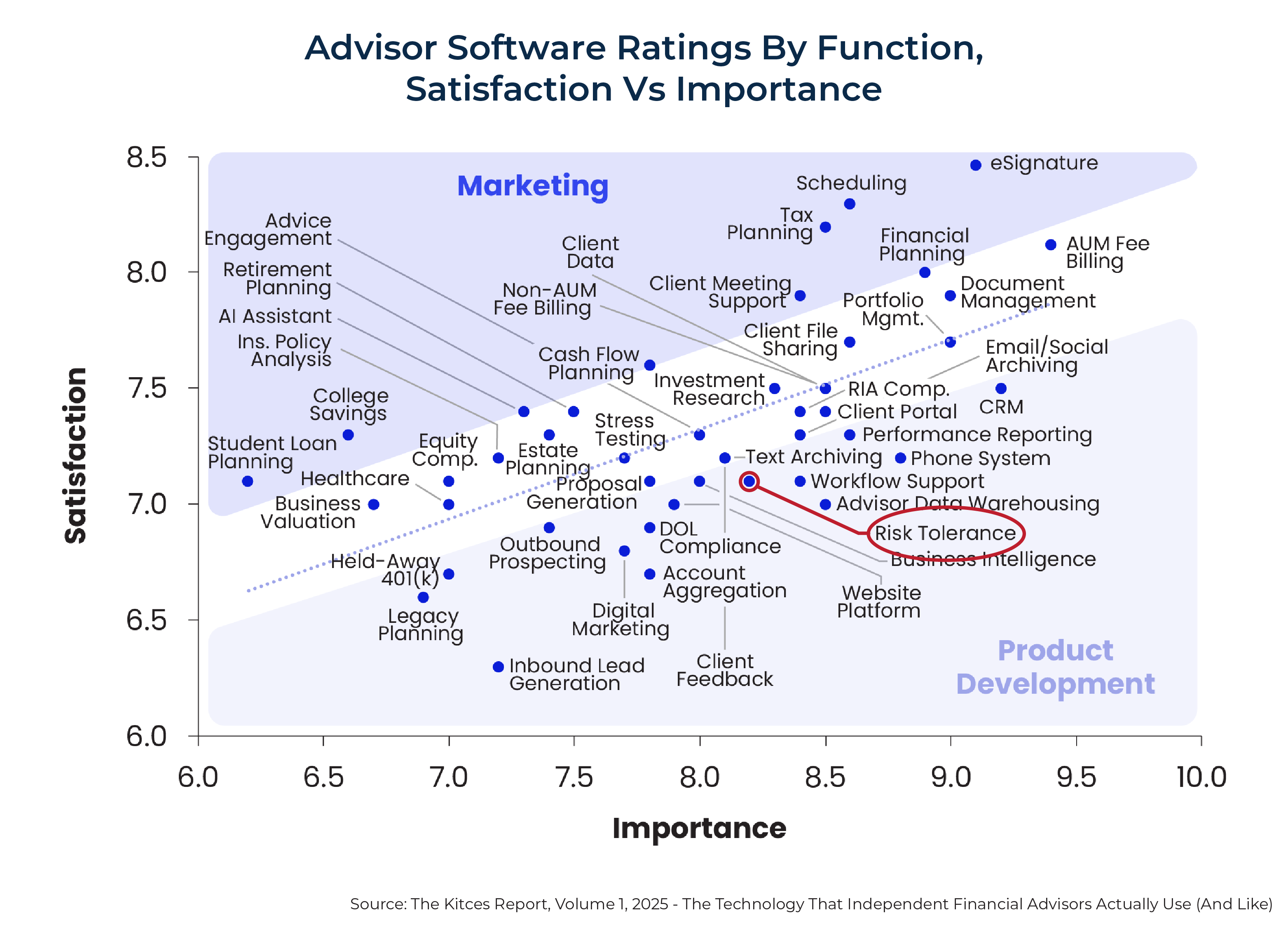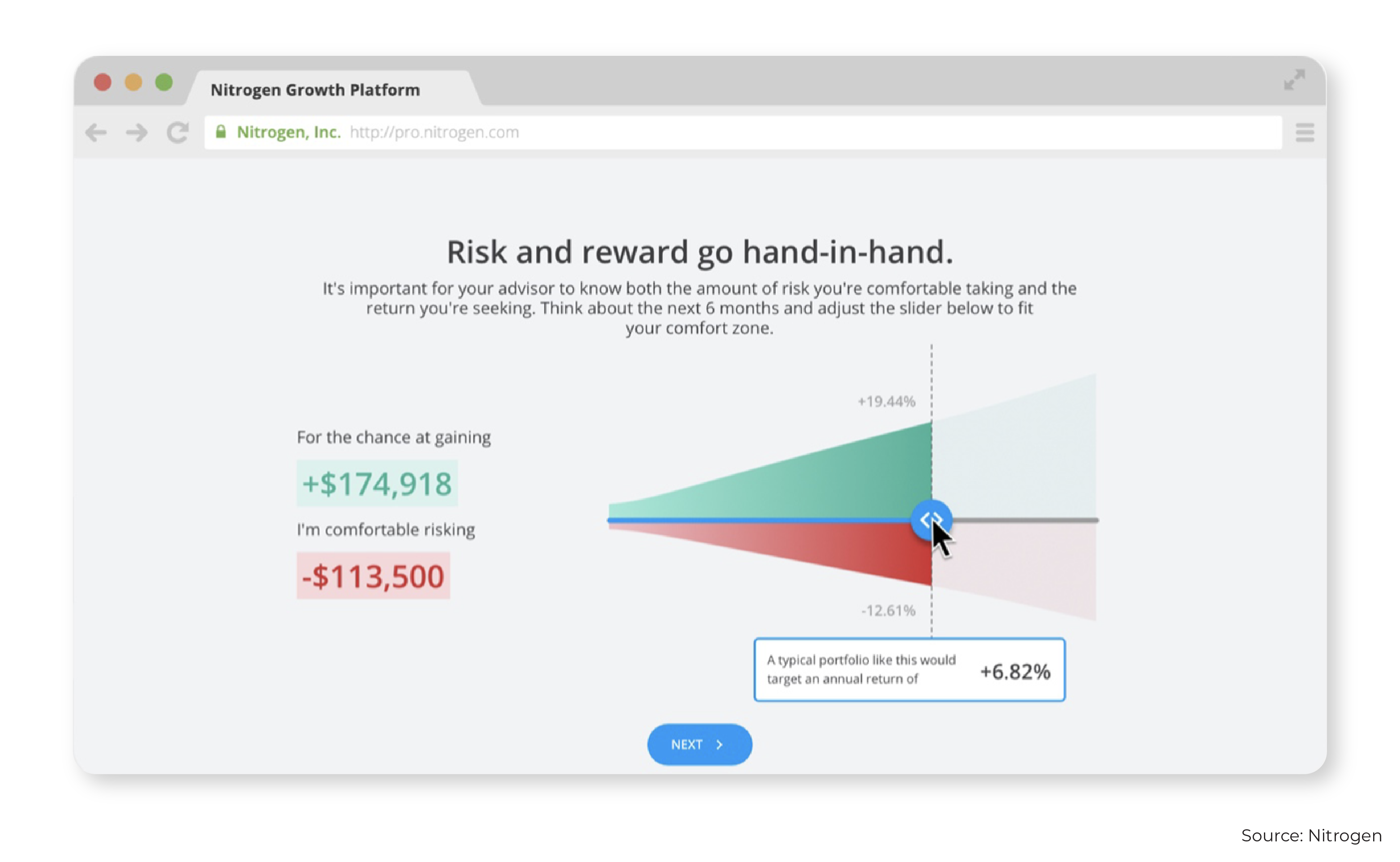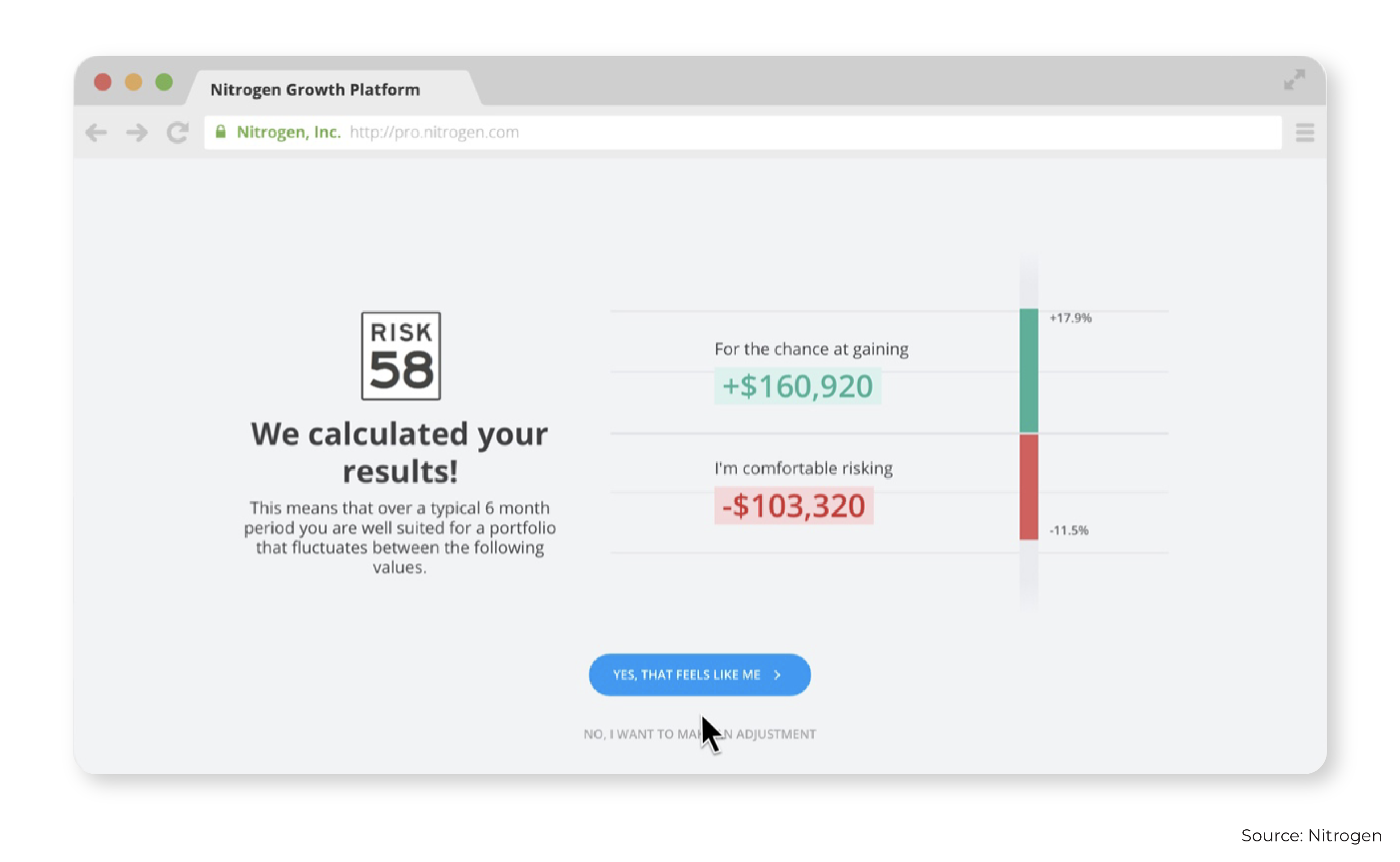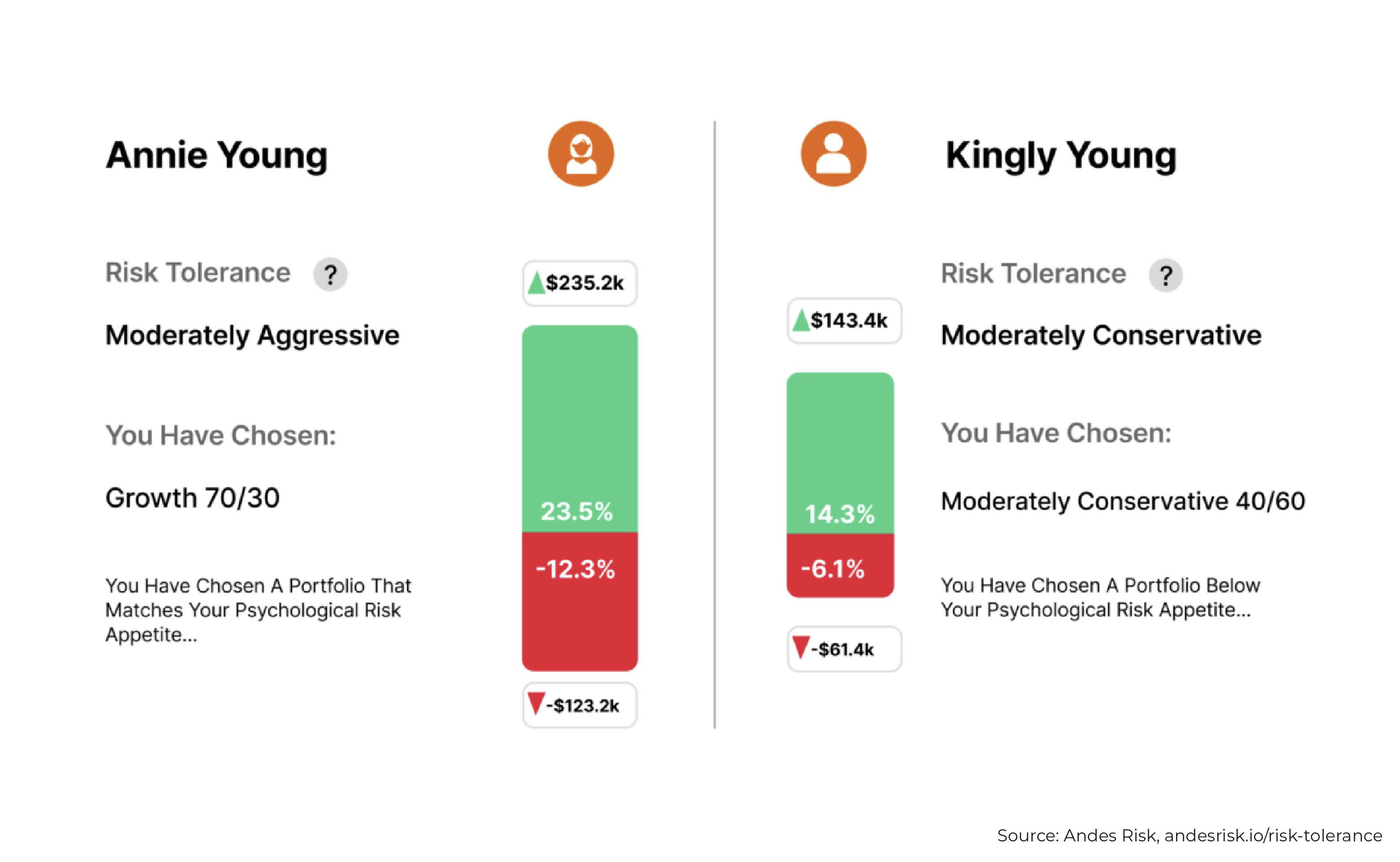Executive Summary
For the last 20 years, Risk Tolerance Questionnaires (RTQs) have served as a standard tool in the advisory space for assessing a client's long-term attitudes and behavior toward investment risk. Yet despite their widespread use, many advisors remain unsatisfied with current RTQ technology. The newest Kitces Research on The Technology That Financial Advisors Actually Use (And Like), presented for the first time in this article, found that while risk tolerance tools are considered important, satisfaction continues to lag – highlighting a disconnect between the perceived value of these tools and how they're currently being used.
One overlooked reason for this dissatisfaction may be that RTQs are often used only after a client relationship has already been established – by which point most advisors are already applying a holistic approach to align a client's portfolio with their risk tolerance, goals, and reactions toward market volatility. And at that stage, a client's true perspective on risk may no longer be fully reflected by their behavior, as their risk attitudes may be filtered through the ongoing presence of their financial advisor – making the value of the RTQ less clear.
However, when used earlier in the process – before the relationship begins – RTQs can serve a different and perhaps more powerful role. Rather than simply measuring risk to inform portfolio design, they can help prospects recognize overlooked risks in their current portfolio, along with the gap between how they understand risk and how they actually behave. This, in turn, helps clarify the financial advisor's value by illustrating how their services can address these gaps. When used at the prospecting stage, RTQs can offer a tangible, personal reason for people who are otherwise 'on the fence' about hiring an advisor – serving as effective self-persuasion tools that allow prospects to articulate their own reasons for seeking advice.
To use RTQs as an effective prospecting tool, three elements are especially important: 1) Personal data inputs to make results feel relevant and accurate; 2) a clear (but brief) explanation of how risk is being scored, to build trust in the methodology; and 3) a visible connection between the results and the advisor's recommendations, so prospects can see the difference between their current approach and the guidance available.
Ultimately, the key point is that RTQs can be most effective when used with investment-focused prospects – not clients. When results are framed in a way that feels personal and actionable, RTQs can help prospects identify their concerns, recognize what's at stake, and clarify their own reasons for engaging a financial advisor – without needing to be explicitly persuaded of the value of financial advice. And for those who are open to working with an advisor but haven't yet found a reason to take the first step, that shift may be all it takes to move them from ambivalence to action!
When I was training for a marathon, I couldn't figure out why I kept finishing my distance runs feeling sick and exhausted – not just for a few hours, but for the rest of the day. By the second hour of running (usually around mile six of my fifteen-mile route), a pounding headache would set in and my legs would start to feel like lead. I knew that I could run the distance, so it didn't make sense that my physical ability wasn't correlating with my actual (and increasingly dismal) performance.
The solution for this came rather accidentally, when I ate an entire half a pizza the night before (the amount of training I was doing had me hungry all the time) and, at my husband's suggestion, brought Gatorade on my run. Lo and behold, I found I had transformed into a modern female Hermes, bolting across the hills of Cincinnati. The second hour of my distance run became my favorite part of the distance run.
That was when I began to truly understand the impact that food intake and blood sugar levels can have on athletic performance. Of course, I'd known on a logical level that it mattered. But my past behavior hadn't aligned with that knowledge. I hadn't realized how much I needed to adjust my food choices and caloric intake to achieve my running goals.
This short story about running, risk, and human behavior isn't really about roadblocks in my marathon training progress (which, yes, could have been resolved with a Google search). The real point is this: There were several noticeable gaps between my professed goals and my actual behavior – even though I cared deeply about the outcomes and would have considered myself reasonably knowledgeable about sports and sports training.
In financial planning, a similar gap between goals and behavior is often demonstrated in risk assessments. A client may say they have a certain tolerance for risk, but their actual investment decisions might tell a different story. Not because clients don't care about their investment outcomes or financial future, but because it takes a lot of continual work, adjustment, and reflection to create a portfolio that actually reflects both their risk tolerance and their preferred behaviors.
The Current Field Of Risk Tolerance Questionnaires (RTQs)
Today, most advisors assess a client's risk tolerance during the client onboarding process. This step is required as a part of the "Know Your Client" (KYC) FINRA rule 2090, which states that "Every member shall use reasonable diligence, in regard to the opening and maintenance of every account, to know (and retain) the essential facts concerning every customer". In short, advisors must exercise due diligence to ensure that the investments they recommend align with a client's risk tolerance and risk capacity.
Historically, this regulation helped ensure that advisors recommended products aligned with a client's risk tolerance and overall goals. However, as financial advice has evolved – and the advisor-client relationship has shifted from largely transactional experiences to longer, ongoing partnerships – advisors have an even stronger incentive to ensure that their clients are happy with their investment decisions.
To demonstrate compliance with KYC, advisors generally rely on one of three approaches:
- A formal Risk Tolerance Questionnaire (RTQ);
- A documented conversation about the client's risk tolerance and overall goals; or
- A blended method combining elements of both.
Many Advisors Are Dissatisfied With Their Risk Tolerance Solutions
As a result of the FINRA Know Your Client (KYC) requirement, Risk Tolerance Questionnaire (RTQ) solutions have been a mainstay of the advisory space for the last 20 years. Yet, despite their ubiquity, many advisors aren't fully satisfied with the tools available to assess risk.
Findings from the 2025 Kitces Research Study on The Technology That Financial Advisors Actually Use (And Like) revealed a disconnect between how important advisors find RTQs and how satisfied they are with current technology solutions. Survey respondents generally agreed that risk tolerance technology solutions are important (rating importance at 8.2 out of 10), but satisfaction with those solutions lagged behind at 7.1 out of 10. Notably, this gap has widened in the last two years, with importance rising 0.4 while satisfaction dropped 0.2.
This satisfaction gap becomes more meaningful when viewed alongside broader workflow trends. Kitces Research found a linear divide between two types of technology solutions:
- Those with high satisfaction but lower uptake, which may need stronger marketing; and
- Those where satisfaction is low but importance is high, which signifies a greater need to invest in product development.
In particular, risk tolerance technology clearly falls into the latter category – highlighting a mismatch between advisor needs and what's currently available.
In fact, many advisors opt out of risk tolerance tech solutions entirely – despite the compliance requirement associated with the category, RTQ tools have just a 49% adoption rate. Even self-built solutions tend to fall short. Risk tolerance technology ranks as the second-most likely to be self-built out of 45 total tech categories.
Yet at the same time, given the lower satisfaction ratings of RTQs, many advisors haven't yet settled on a specific method for doing so.
Which raises the question: Why is there such broad dissatisfaction with RTQs?
The RTQ Behavior Gap
Advisors' dissatisfaction with RTQs persists in part because of the gap between RTQ results and a client's actual behavior. That is, the results often fail to reflect a client's behavioral reality or their actual capacity for risk. Many RTQs are not psychometrically designed, which means they may not reliably capture a client's long-term attitudes toward risk and behavior patterns.
Even when an RTQ is well-constructed, a client may inadvertently introduce inaccuracies in their responses due to blind spots in their own perception of risk. As an analogy, consider my running story mentioned earlier. My goal was straightforward: to run a marathon. But I didn't initially recognize the gap between my behavior and my less-than-stellar training results. (And for the record, since I've already thrown myself under the bus: I did make considerable adjustments to my food and electrolyte intake and successfully completed a marathon in spring 2023!)
Now, consider the parallels to how a client perceives risk. A client may have a clear money goal – like retiring comfortably. Imagine a client in their fifties who has had their entire career accumulating wealth and likely decades thinking about retirement. Yet, when completing an RTQ, they may struggle to connect those goals with their portfolio or investment behavior. Many clients may be navigating implicit beliefs about risk that are hard to capture in a questionnaire.
For example, concerns about a loved one's health, the market and political atmosphere, and upcoming life events such as retirement can all make a client more or less risk-averse than what they might perceive (and reflect in their RTQ) as their 'default'. Even within couples, one partner's reactions can influence the other's, inadvertently pulling them away from their own 'default' level of risk tolerance!
Given how these elements can shape how a client feels about risk, it's not surprising that many advisors opt for interviews rather than questionnaires. While doing so may not be a perfect solution, they find interviews offer a better feel for how clients actually behave, how they perceive risk, and where any gaps in understanding may lie.
Nerd Note:
There are good RTQs out there, and many providers work hard to design tools that anticipate and adjust for the behavioral nuances noted above. In particular, psychometrically designed assessments – which aim to reliably capture a client's long-standing attitudes toward risk – can be a valuable option.
Kitces Research on Advisor Technology includes detailed rankings on advisor satisfaction and adoption of these tools by software type and firm size.
Some advisors opt to build their own risk tolerance assessments. In 2023, satisfaction scores with self-built risk tolerance technology averaged just 6.8 out of 10, with value scoring at 8.5 out of 10. But in the past two years, satisfaction scores have skyrocketed, now averaging 8.1, with value increasing to 9.0. The percentage of advisors using self-built RTQs as either a primary or secondary solution has also increased over the same time period, with primary solution adoption rates increasing from 4.1% to 5.2%. (Most firms using self-built risk tolerance technology tend to have smaller teams – typically generating less than $500k in revenue and employing four or fewer full-time employees.)
At smaller firms, where RTQs are often handled directly by one or two advisors, self-built tools can be especially useful. But as firms grow – and the need for consistent, scalable systems increases – many firms naturally graduate away from self-built assessments to more robust, third-party solutions.
Interestingly, RTQs are often used in multi-faceted ways. In AdvisorTech surveys, it's common for a single piece of technology to perform several jobs for firms. For example, Nitrogen – the leading third-party software for RTQs – is also used by advisors for retirement planning, investment research, proposal generation, and portfolio stress testing. Many of these overlaps are inherent to the technology itself; for instance, it would be difficult to assess risk tolerance without some degree of portfolio stress testing. Still, using RTQs for proposal generation is a relatively recent development – and may signal greater potential on how they may be leveraged differently across the planning process.
Risk Tolerance Questionnaires (RTQs) Can Be Useful – But They Have To Be Used Differently
Perhaps the real reason many advisors are frustrated with their RTQ solutions is that these questionnaires are being used too late in the client relationship. By the time a client has committed, most advisors are already taking a holistic approach to managing risk – drawing from ongoing conversations, portfolio design, and the client's reactions to market events. At that point, they're focused on aligning the client's portfolio with their risk tolerance, goals, and reactions toward market volatility. The behavioral gap that RTQs may reveal is still present, but it's harder to act meaningfully after the relationship is established, especially in a way that feels like a value-add for the client.
In practice, the advisor is already gathering richer, more personalized context than what an RTQ can provide. And that can make the questionnaire feel redundant or disconnected from what actually drives decisions. In effect, the RTQ can seem like little more than a box to check for compliance.
Another challenge of using RTQs post-onboarding is that they're not always assessing a client's true attitudes toward risk. More often, what they're really evaluating is a client's mindset about risk within the context of the ongoing client–advisor relationship.
So, instead of asking whether an RTQ reveals risk attitude or behavior, consider this: What if the real value lies in revealing the gap between how the client understands risk and how they actually behave? And what if advisors were to explore that gap earlier – not using it as a post-onboarding checkmark, but as a tool for helping prospects understand the value of working with an advisor? Might RTQs not only provide a means to assess risk but also serve as tools to engage prospects earlier in the relationship?
The Four Traits Of Prospecting Investment Surveys
While most RTQs today are used post-onboarding, the idea of using questionnaires to engage prospective clients isn't new. In fact, many advisors historically used investment surveys as a prospecting tool designed to highlight the gap between a prospect's portfolio and the portfolio they could potentially have with the advisor's guidance.
These portfolio assessments typically followed a four-part structure:
- Assessment of the prospect's current portfolio. The advisor would gather information on how – and how much – a client had invested, and evaluate how the portfolio was likely to perform.
- A proposed alternative. The advisor would offer a suggested reallocation or new investment strategy – in essence, a pitch of what the advisor would do differently.
- A metric to compare portfolio performance. These measurable standards, often set by the advisor, would include things such as overall performance, risk, or tax efficiency.
- Quantification of the difference. This was the core selling point: a tangible side-by-side comparison showing how the advisor's portfolio might outperform the prospect's current one in certain key areas.
In an ideal scenario, the advisor would present a persuasive combination of superior investment returns and effective risk management in a tangible, visible way.
However, it's fundamentally difficult to 'sell' a prospect on investment return outperformance alone. While investment analysis is inherently quantitative, it's not necessarily inherently objective. And because the advisor chooses the metric used to compare portfolios – performance, risk, tax efficiency, something else – those choices can potentially tilt the comparison in their favor. As a result, prospects may naturally wonder if the comparison was deliberately arranged to showcase the advisor's portfolio in the best possible light.
There are other challenges with selling a client on investment performance. For example, clients who have highly concentrated or aggressive portfolios that have recently performed well may be difficult to convince that the outcome was due to good luck and not to strategy. An over-concentrated, risky portfolio may actually look quite robust in these portfolio assessments, and it can be difficult to explain why a more conservative portfolio may be a better choice in the long run.
Put simply, it's hard to convince a lottery winner that lottery tickets are a bad investment. For these reasons and others, many advisors don't frame their investment management value around performance alone – yet that was often exactly what investment surveys focused on.
How RTQs Can Translate To Prospects
While return-based investment surveys have fallen out of use as lead generation tools, RTQs may offer a more effective alternative. Instead of marketing projected returns, RTQs emphasize a more emotionally resonant insight: the misalignment between a prospect's risk tolerance and their current portfolio.
For many prospects, completing an RTQ may show that their portfolio is under-diversified or misaligned with their actual comfort level – even if they've seen strong recent performance. Unlike traditional investment surveys, this approach doesn't rely on projecting superior returns. Instead, it highlights overlooked risk and reframes the advisor's value around alignment and long-term fit.
This kind of reframing can be especially powerful for prospects who have considered working with an advisor but still feel ambivalent about taking action. If someone thinks they've 'done okay this far' without help from an advisor and isn't facing immediate financial pressure, they may not see a compelling reason to make a change. As Meghaan Lurtz explains:
Change, especially when it involves financial matters, can be inherently challenging. Many people are slow to embrace it, especially if they perceive themselves as 'doing okay'. Prospects who aren't in immediate financial distress – such as those with a steady income and a decade or more from retirement – often experience ambivalence out of uncertainty rather than avoidance. While they're curious about financial planning, they're unsure if it's the right step or truly necessary. They might even view financial planning as a 'good idea' but carry doubts about timing, relevance, and, ultimately, the value that a financial advisor can add to their lives.
These patterns reflect findings from Morningstar's 2023 study on why people hire financial advisors: One of the most common reasons was to address a specific financial need or time-sensitive event, like retirement planning, tax strategy, or the loss of a spouse.
When prospects lack a clear driving point prompting action, they may remain in a state of ambivalence for months – or even years – before reaching out to an advisor. They often need a specific 'something' to move them from ambivalence to action. In these situations, RTQs can function as a kind of self-persuasion – prompting ambivalent prospects to input their own information and see the results that highlight previously unrecognized risks in their current portfolio. That insight can give them the personal 'event' they need that creates just enough tension to persuade them to act.
How RTQs Use Messaging That Creates Action For Prospects
Another reason RTQs work particularly well as self-persuasion tools is that they make risk feel tangible. Even though humans are uniquely capable of thinking ahead and planning for the future, we often struggle to evaluate long-term risks well – especially in areas like investing, where the stakes are high and the math can feel abstract. We tend to underestimate risk, and unless we've developed real expertise, it's hard to know when a portfolio is misaligned or needs adjustment.
However, not everyone has the time or desire to become financial experts (and if clients did become experts, they might just become financial planners themselves!). This is where risk messaging becomes so powerful.
Risk prospecting theory studies how the way risk is communicated influences behavioral outcomes. In other words, it examines how to communicate risk in a way that encourages people to act in their own best interest. (For example, they may study the type of messaging that persuades people to stop smoking or start saving for retirement.)
There is a lot to discuss in terms of risk prospecting theory, but in brief, there are two intersecting frameworks that come into play:
- Gain Versus Loss. Emphasizes positive outcomes (e.g., more opportunities) or negative consequences (e.g., fewer opportunities).
- Antecedent Versus Consequent. Focuses either on the action that creates the result (antecedent) or the result itself (consequent).
An example of how this rhetoric applies to financial behaviors can be seen in the graphic below:
In general, people tend to be more sensitive to potential losses but are more likely to act when the messaging appeals to their intrinsic motivation. For example, it's often more motivating to think, "I'm making this decision to be a good investor" instead of "I'm making this decision to avoid being a bad investor".
RTQs use both dimensions of risk prospecting theory. Consider, for example, how Nitrogen illustrates both potential gains and losses when prospects input their own investing information.
Visualizing both risk and reward does two powerful things:
- It makes the risk tangible to prospects, helping them see the stakes more clearly; and
- It supports intrinsic motivation by showing how the gain or loss becomes personal.
This can help the prospect arrive at a range of personal takeaways, such as:
- I have more risk than I realized. If I don't fix things, I could be in some trouble.
- Oh, I've been worried about having enough money in retirement. I didn't fully realize the difference that contributing even slightly more to my savings now would make in the future when I'm ready to retire.
- I'd like to rebalance this, but I don't want to get things wrong.
Each of these takeaways can be tied to a clear action item related to portfolio management – naturally leading the prospect to contact the advisor.
How To Use Risk Tolerance Questionnaires (RTQs) As An Effective Sales Tool
When structured well, RTQs can be a powerful prospecting tool – especially for investment-oriented prospects. Advisors can leverage the pain points highlighted by portfolio risk to create a compelling value proposition, without needing to compete on investment performance and 'persuade' based on investment returns alone.
Nitrogen has played an enormous role in bringing RTQ-based prospecting into the modern, mainstream AdvisorTech space, which is why it's categorized under "Sales Enablement" on the AdvisorTech Map, setting it apart from other risk-assessment platforms. Over the last few years, many other AdvisorTech companies have followed suit, either emerging as new entrants or adding features that integrate risk tolerance into the prospecting process. Risk tolerance solutions such as Andes Risk and Tolerisk have also gained traction by positioning themselves as RTQ-based prospecting tools.
Nerd Note:
In general, risk tolerance solutions used for prospecting can be implemented in one of two areas: 1) as website plug-ins, where prospects enter their own high-level information, or 2) as information-gathering tools sent after an initial meeting request and before the prospect officially becomes a client, which often requires a document upload.
There are pros and cons to both solutions. For example, self-reported information may be less accurate than what's pulled from official documents. However, for the type of prospect being discussed here, self-reported information may serve as a 'good enough' starting point – especially if it helps spark the motivation to take action.
Using RTQs Effectively As A Prospecting Tool
To function as a truly effective sales tool, an RTQ needs to go beyond hypothetical scenarios and capture a prospect's actual data and information. This is what makes the exercise self-persuasive and emotionally tangible. Instead of reflecting on hypothetical scenarios or abstract case studies, the prospect is engaging directly with their own real numbers – which creates stronger internal motivation to take action.
What also makes a prospecting-oriented RTQ effective is its ability to quantify a prospect's risk in a clear and meaningful way. Crucially, this often includes a visual display of the possible outcomes based on the prospect's inputs and allows for space to adjust. One example of this can be seen in Nitrogen's display for prospects after they complete their assessment. The tool generates a personalized "Risk Number" and pairs it with a visual that clearly illustrates the range of possible outcomes—both gains and losses—that align with that risk level. The projected dollar values help make those possibilities feel real and specific, rather than abstract.
It's also crucial for the RTQ to give the prospect a basic explanation of how their risk is being scored. This doesn't have to be complicated. Even a brief statement like the language used in the graphic above –explaining how results were calculated "over a typical 6-month period" – can give prospects valuable context, reassuring them that the numbers are grounded in reality. This clarity helps build trust that the assessment is based on something concrete, not just a black-box algorithm.
Finally, the results of the RTQ should have some connection to the advisor's recommendation. The contrast between a prospect's current portfolio and a hypothetical adjusted portfolio is often enough to help clients understand new pain points that they may not have been aware of before. Advisors can then center their marketing call-to-action around these areas to highlight potential improvements or adjustments.
For example, the graphic below illustrates the side-by-side contrast between two potential paths presented to the prospect, who is asked to consider a potential gain with greater risk (Option A) against a smaller, guaranteed gain (Option B). This exercise forces the client to reflect on their comfort with risk – not just in abstract terms, but through a concrete tradeoff between real-dollar outcomes. This can be an effective self-persuasion tool, which helps the prospect recognize their own preferences and identify how they could benefit from the advisor's guidance.
Consider what sort of messaging and action items can direct prospects to discuss their results and how they can fix this in the long term. For example, advisors might use some of the following calls to action:
- Questions? Set up a free consulting call to discuss your risk tolerance score – and how [Firm] can help you reach your goals.
- Want help balancing your portfolio? Set up an initial call with [Firm] and discuss how to get started!
This is one of the great benefits of using RTQs at this step in the prospecting process. The advisor is still able to meet Know Your Client (KYC) compliance requirements, but can also leverage the process as a tangible value proposition. The prospect is more likely to act on a relatable starting point that helps them understand the value of a financial advisor.
In short, risk tolerance questionnaires can be a powerful tool for prospecting – especially for those who are open to working with an advisor but haven't found a clear reason to take the first step. When framed in a way that feels personal and actionable, these tools give prospects the chance to identify their concerns, see what's at stake, and articulate their own reason for engaging a financial advisor – without needing to be explicitly persuaded of the value of financial advice.
Ultimately, the key point is that risk tolerance questionnaires help prospects connect the dots between where they are now and where they want to go – turning abstract financial uncertainty into a conversation they feel ready to have. And that shift alone can be enough to move them from ambivalence to action!









